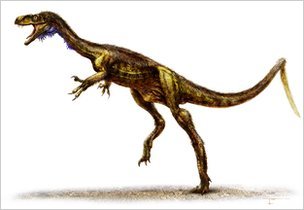Dating of new dinosaur fossils and volcanic ash around them by researchers from has led them to cast doubt on the idea that dinosaurs appeared and opportunistically replaced other animals. They seem to have existed side by side and gone through similar periods of extinction.
Geologists from Argentina and the United States announced earlier this month the discovery of a new dinosaur, Eodramaeus, or "dawn runner," that roamed what is now South America 230 million years ago, at the beginning of the age of the dinosaurs. Eodramaeus was a predatory dinosaur that walked (or ran) on two legs and weighed 10 to 15 pounds.
The Eodramaeus fossils come from a valley in the foothills of the Andes in northwestern Argentina. More than 200 million years ago, it was a rift valley on the western edge of the supercontinent Pangaea, surrounded by volcanoes. It's one of the few places in the world where a piece of tectonically active continental margin has been preserved, said Isabel Montañez, a UC Davis geology professor and a co-author of the Science paper.

Montañez, with Brian Currie from Miami University, Ohio, and Paul Renne at UC Berkeley's Geochronology Center, have conducted earlier studies of the ancient soils from the valley, dating layers of ash and researching how the climate changed. Those climate studies have been published previously.
According to Montañez, there are two major temporal boundaries in the geology of the era: The Carmian-Norian boundary at 228 million years ago and the Triassic-Jurassic transition at about 210 million years ago. Geologists have long thought that dinosaurs jumped in number and variety at both points, opportunistically replacing other reptiles.
But the carefully aged fossils from South America show no such increase at the Carmian-Norian boundary, Montañez said. Rather, dinosaurs were as diverse and abundant before the transition as later in the Jurassic, although several species of both dinosaurs and other animals went extinct at the boundary.
At that time, the climate in the valley changed from semi-arid, like today's Mojave desert, to more humid. It's not clear whether that was a global phenomenon or local to that area, Montanez said.
"Those dinosaurs were perfectly happy before the Carmian-Norian transition," Montanez said.
It may be that there are missing pieces from the fossil records elsewhere, Montanez said, noting that, "nowhere else is this well dated."





Comments